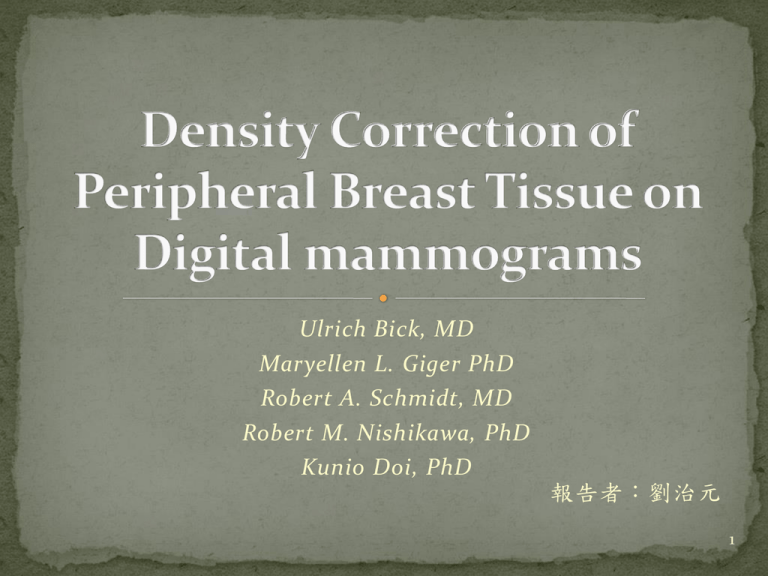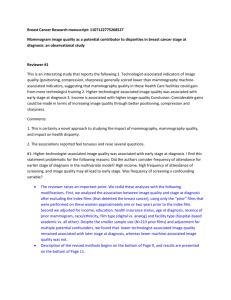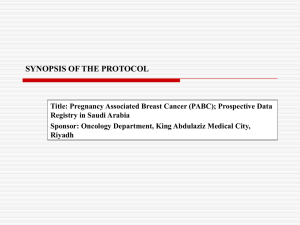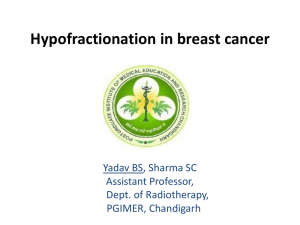
Ulrich Bick, MD
Maryellen L. Giger PhD
Robert A. Schmidt, MD
Robert M. Nishikawa, PhD
Kunio Doi, PhD
報告者:劉治元
1
ABSTRACT
INTRODUCTION
DESCRIPTION OF THE ENHANCEMENT
ALGORITHM
EVALUATION OF THE ALGORITHM
ADVANTAGES AND LIMITATIONS OF
USING THE ALGORITHM
CONCLUSIONS
2
When digital mammograms are viewed on video
displays, evaluation of the skin and subcutaneous
tissue is often difficult and may require special window
settings.
An algorithm has been developed for selective
enhancement (ie, density correction) of the dark
peripheral portions of the breast on mammograms.
3
After enhancement, skin and breast parenchyma can
be evaluated simultaneously without the need for
different window settings.
When tested on a set of 400 digitized mammograms,
the density correction algorithm significantly (P
< .0001) increased the maximum area of breast tissue
visualized simultaneously at window width settings of
0.5-2.0 △OD (optical density).
4
The algorithm for correcting the density of peripheral
breast tissue substantially facilitates and improves the
display of digital mammograms and thus will be a
valuable component of an integrated workstation for
computer-aided diagnosis in mammography.
5
Evaluation of the skin and subcutaneous tissue on
mammograms is often difficult because of the high
optical density (OD) of these areas.
visualization of these peripheral areas on soft-copy
displays requires wide window settings, which result in
loss of contrast in the center portion of the breast.
Special anatomic filters have been designed for x-ray
beam equalization in mammography , but they may
cause artifacts and have not been accepted in routine
clinical practice because of difficulties in handling.
6
Another approach is the use of scanning equalization
mammography, which is performed with a modulated,
segmented fan beam.
Although this technique may correct large differences
in regional density in the center part of the breast, it
usually cannot uniformly correct the rapid density
slope along the semicircular periphery of the breast
because of the rectangular design of the fan beam
segments.
7
we are developing an automated post-processing
algorithm for digital mammograms that selectively
enhances the dark peripheral portions of the breast to
match the density of the center part of the breast.
8
After an automated
segmentation of the
digital mammogram
and identification of
the skin line
9
the distance from the skin is calculated for each pixel
inside the breast by using a so-called Euclidean
distance map .
This map codes the distance from the skin for each
image point in the form of a gray value .
10
11
a fitted enhancement curve is created; this curve
defines the necessary correction value for each breast
pixel as a function of the distance from the skin.
12
After application of the
enhancement algorithm,
skin, subcutaneous tissue,
and breast parenchyma
have similar average
density values and can be
evaluated simultaneously
without the need for
different window settings .
13
The calculation time for the algorithm depends on the
size of the breast and ranges between 30 and 50
seconds for a full-size 2,048 x 2,560 image (when
performed on a Power station 590 [RISC 6000 series;
IBM, Austin, Tex]).
More than 50% of this time is spent to create the
Euclidean distance map, whereas image segmentation
takes only about 2 seconds.
14
Methods
The algorithm for correcting peripheral density was
tested on the four-view screening mammographic
studies of 100 consecutive patients in whom nonpalpable breast cancer was diagnosed at the University
of Chicago between 1987 and 1993.
The 400 mammograms were digitized with a laser
scanner (Lumiscan 100; Lumisys, Sunnyvale, Calif ) at
100 μm with a 10-bit gray scale and a dynamic range of 03.5 OD.
15
For evaluation, the original and density-corrected
images were displayed back-to-back on a computer
monitor.
Density correction results were subjectively rated by four
expert mammographers (R.A.S., R.C. Haldemann, C.J.
Vyborny, D.E. Wolverton) into the following five
categories.
16
five categories:
(a) optimal results, with uniform density along the complete
periphery of the breast
(b) minor density irregularities, with smooth areas of slightly
higher or lower density
(c) somewhat distracting density irregularities, but with no
interference with interpretation;
(d) severe density deviations or artifacts that might interfere
with interpretation
(e) complete failure of the density correction algorithm.
17
As a quantitative measurement, the maximum fractions
of the breast area visualized simultaneously at window
width settings of 0.5, 1 .0, 1 .5, and 2.0 △OD (difference
in ODs between upper and lower window limits) were
calculated for both the original and density-corrected
images.
These OD ranges correspond to 146, 293, 438, and 585
gray levels, respectively, in the digitized image (10-bit
linear digitization from 0 to 3.5 OD).
18
For statistical analysis of the differences between the
original and density-corrected images, the Wilcoxon
signed-ranks test for matched pairs was used.
As a measure of the above-chance inter-observer
agreement, the weighted k for ordered categorical data
was calculated for each pair of observers .
19
Results
20
21
In 82% of cases with a discordant rating between two
observers, the disagreement was between categories 1
and 2.
This may reflect the difficulties of the observers in
consistently distinguishing between cases with minor
irregularities (category 2) and cases with optimal results
(category 1).
22
23
Improved Digital Display
One of the main limitations of current video monitors
for viewing radiographs and especially mammograms is
the small dynamic range compared with that available
when radiographic film is viewed on a conventional light
box .
When the described density correction algorithm is
used, a larger portion of the breast can be displayed at a
narrow (high-contrast) window setting , thus
compensating for the smaller dynamic range of the
digital display.
24
25
Aid to Computer-assisted Detection
In addition to improving the display of digital
mammograms, the density correction algorithm is used
as part of a new single-image method for computerassisted detection of mass lesions on mammograms .
Several of the feature extraction steps used in
characterization of masses seen on mammograms are
also gradient based and will benefit from use of a
density-corrected image as input.
26
Limitations
the curve may not be optimally suited for the entire
circumfcrcnce of the breast.
The density correction algorithm crucially depends on
the quality of the digitization process.
27
28
29
The developed algorithm for correcting the density of
peripheral breast tissue substantially facilitates and
improves the display of digital mammograms.
On density-corrected mammograms, the skin,
subcutaneous tissue, and breast parenchyma can be
evaluated simultaneously at high contrast with use of
the same window setting.
This algorithm will thus be a valuable component of an
integrated workstation for computer-aided diagnosis
in mammography.
30
31







